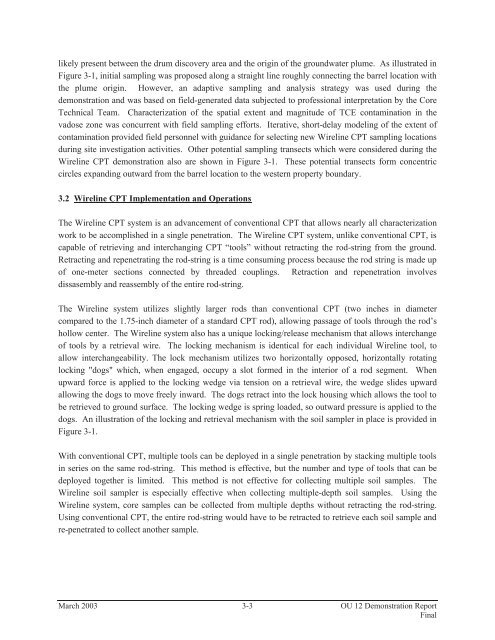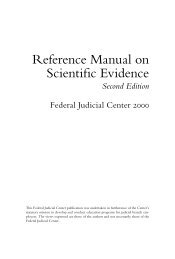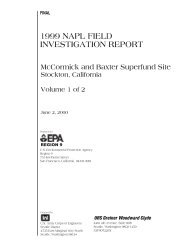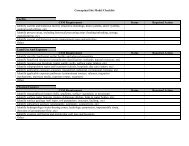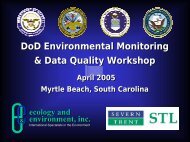Source Zone Delineation Demonstration Report - Triad Resource ...
Source Zone Delineation Demonstration Report - Triad Resource ...
Source Zone Delineation Demonstration Report - Triad Resource ...
You also want an ePaper? Increase the reach of your titles
YUMPU automatically turns print PDFs into web optimized ePapers that Google loves.
likely present between the drum discovery area and the origin of the groundwater plume. As illustrated inFigure 3-1, initial sampling was proposed along a straight line roughly connecting the barrel location withthe plume origin. However, an adaptive sampling and analysis strategy was used during thedemonstration and was based on field-generated data subjected to professional interpretation by the CoreTechnical Team. Characterization of the spatial extent and magnitude of TCE contamination in thevadose zone was concurrent with field sampling efforts. Iterative, short-delay modeling of the extent ofcontamination provided field personnel with guidance for selecting new Wireline CPT sampling locationsduring site investigation activities. Other potential sampling transects which were considered during theWireline CPT demonstration also are shown in Figure 3-1. These potential transects form concentriccircles expanding outward from the barrel location to the western property boundary.3.2 Wireline CPT Implementation and OperationsThe Wireline CPT system is an advancement of conventional CPT that allows nearly all characterizationwork to be accomplished in a single penetration. The Wireline CPT system, unlike conventional CPT, iscapable of retrieving and interchanging CPT “tools” without retracting the rod-string from the ground.Retracting and repenetrating the rod-string is a time consuming process because the rod string is made upof one-meter sections connected by threaded couplings. Retraction and repenetration involvesdissasembly and reassembly of the entire rod-string.The Wireline system utilizes slightly larger rods than conventional CPT (two inches in diametercompared to the 1.75-inch diameter of a standard CPT rod), allowing passage of tools through the rod’shollow center. The Wireline system also has a unique locking/release mechanism that allows interchangeof tools by a retrieval wire. The locking mechanism is identical for each individual Wireline tool, toallow interchangeability. The lock mechanism utilizes two horizontally opposed, horizontally rotatinglocking "dogs" which, when engaged, occupy a slot formed in the interior of a rod segment. Whenupward force is applied to the locking wedge via tension on a retrieval wire, the wedge slides upwardallowing the dogs to move freely inward. The dogs retract into the lock housing which allows the tool tobe retrieved to ground surface. The locking wedge is spring loaded, so outward pressure is applied to thedogs. An illustration of the locking and retrieval mechanism with the soil sampler in place is provided inFigure 3-1.With conventional CPT, multiple tools can be deployed in a single penetration by stacking multiple toolsin series on the same rod-string. This method is effective, but the number and type of tools that can bedeployed together is limited. This method is not effective for collecting multiple soil samples. TheWireline soil sampler is especially effective when collecting multiple-depth soil samples. Using theWireline system, core samples can be collected from multiple depths without retracting the rod-string.Using conventional CPT, the entire rod-string would have to be retracted to retrieve each soil sample andre-penetrated to collect another sample.March 2003 3-3 OU 12 <strong>Demonstration</strong> <strong>Report</strong>Final


